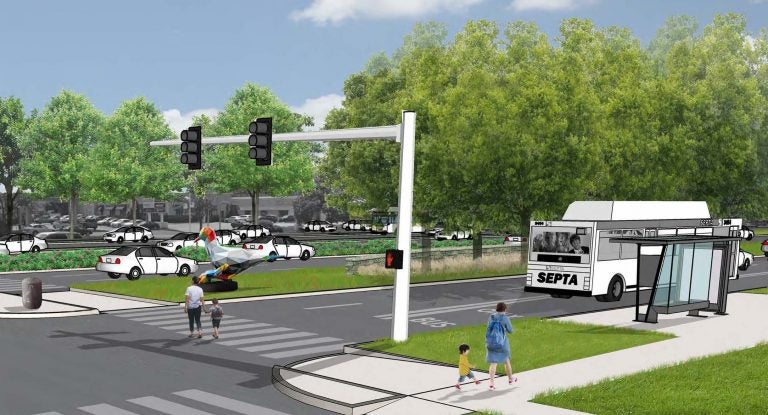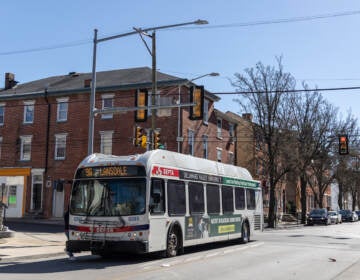Philly to test a bus-forward traffic hack on deadly Roosevelt Boulevard
A traffic design hack is coming to Roosevelt Boulevard. City officials say the new “BAT” lanes will speed up transit commutes.

An artist's rendering of the BAT lanes planned for Roosevelt Boulevard. (City of Philadelphia)
Philadelphia officials have a plan for jokers slowing down buses on Roosevelt Boulevard: the BAT lane.
BAT, which stands for business access and transit, is a new-to-Philly breed of lane that prioritizes buses, and lets cars flow into only to make right turns at intersections or businesses. Never before tried on a major road in Philadelphia, the city is now advancing a plan to test BAT lanes on the Boulevard, the most dangerous road in the city and one of the deadliest in the region.
About 90,000 vehicles travel the 14-mile, 12-lane boulevard daily as it runs from North Broad Street to Bucks County. Twenty-one lives were lost in 2018, and there were 2,700 crashes in the five years prior, of which 139 were fatal. There were eight in 2019, according to recent city crash data.
Over the next two to three years, the city hopes to see those numbers drop through its $5 million Route for Change project, of which the BAT lanes are one element. The traffic design hack aims to speed up the pace of buses on the historic expressway, which cuts through densely population North and Northeast Philly neighborhoods. Current bus travel times are twice that of cars, according to the city’s Office of Transportation, Infrastructure and Sustainability (OTIS).
“We are doing small things now as we work on the bigger more transformative projects,” said Chris Puchalsky, director of policy and strategic programming for oTIS.
SEPTA and the city also launched the Boulevard Direct bus service on Roosevelt in 2017. The express version of the 14 bus runs from Frankford Transportation Center to Neshaminy Mall in Bucks County with only seven stops in between. While bus ridership suffers in the city, the Direct service increased ridership by 13% between November 2017 and October 2018.
The BAT lanes are about as radical as it gets for Philadelphia as it relates to transit-focused corridors. But officials are watching experiments in New York City and San Francisco, where bolder moves have improved transit by limiting car use in congested areas.
In New York, for example, transportation officials restricted passenger vehicle use on a portion of 14th Street, one of the city’s most congested stretches, between 6 a.m. and 10 p.m. The M14 bus route runs on the street.
New York Officials launched the pilot in early October and saw almost immediate improvements with no traffic burden to the surrounding neighborhood. Prior to the project, the M14 was one of the slowest in the city. Now, more than a month later, MTA officials reported bus speeds jumped 29 to 56 percent, and travel time is down 22 to 38 percent. Also, early numbers show ridership grew from 26,000 in September 2018 to 31,000 in October 2019.
Part of the program’s success is also due to the M14’s transition to Select Bus Service, an express service that uses prepaid fares and all-door boarding, and the L train subway service running underneath 14th Street being slowed due for repairs.
And more improvements for the busway are coming. Officials are in the process of adding bus boarding platforms and adding automated cameras on buses to bolster bus lane enforcement.
“It’s about getting people back on to public transit,” said Andy Byford, president of the New York City Transit Authority, a branch of the Metropolitan Transportation Authority. “But to do that you have to make it attractive. And you have to show that it is the best way to go along these key corridors.”
Philadelphia had its own car-free corridor just less than 20 years ago when the city banned cars on Chestnut Street between Eighth and 18th Streets for the Chestnut Street Transitway. The program lasted from 1976 to 2000. Businesses suffered during its run, though the city was in poor financial shape during that time. Nevertheless, the transitway blamed and shutdown.
Puchalsky says a program resembling the transitway or the busway is unlikely to happen any time soon, but the city is doing a lot of peripheral work to address congestion. Bus lane enforcement blitzes, loading zone pilots, and experimenting with a queue jump lane are some of their recent efforts.
Philadelphia is also exploring bus cameras for bus lane enforcement, and City Council is even working on a bill that will increase fines for parking in the bus lanes, Puchalsky said.
WHYY is your source for fact-based, in-depth journalism and information. As a nonprofit organization, we rely on financial support from readers like you. Please give today.







